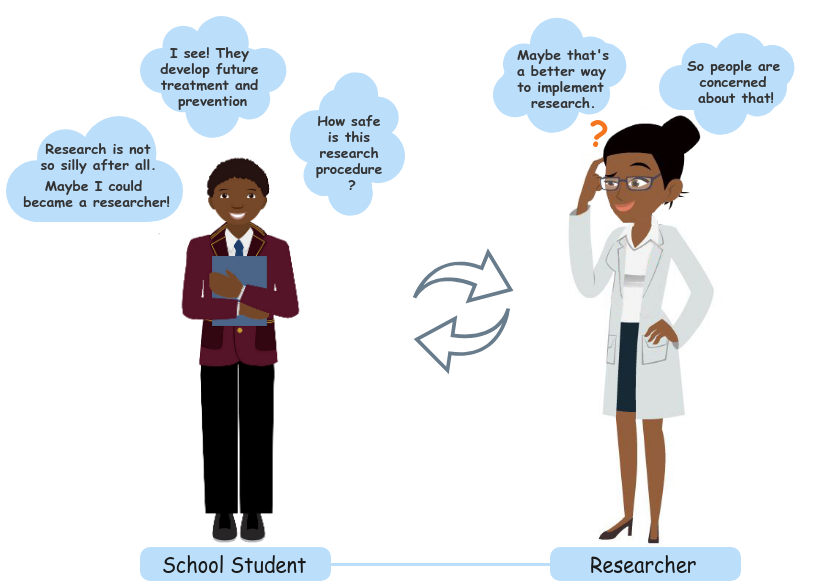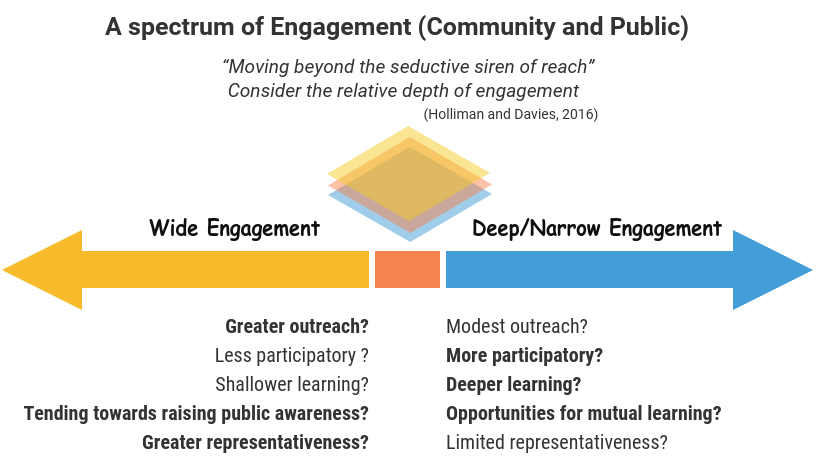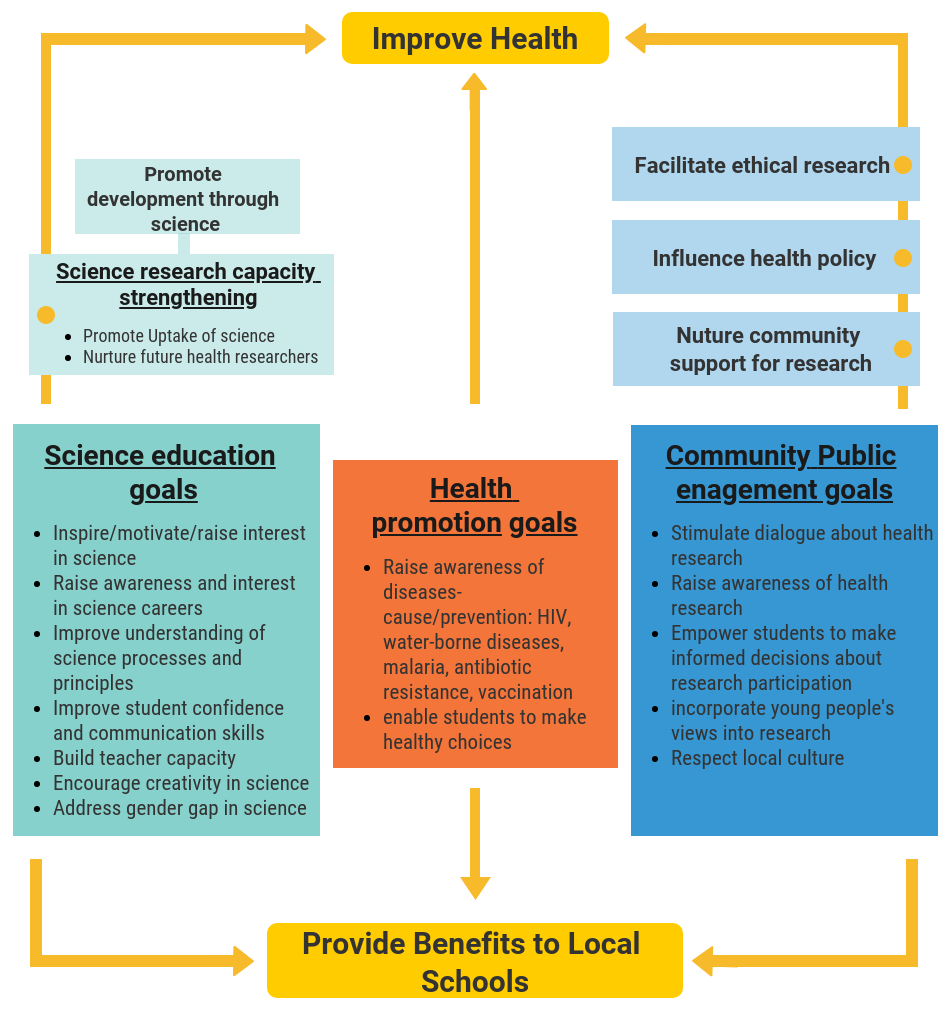Mesh theme on engaging school students with health research using a variety of approaches
Browse project reports, guides and resources within each engagement method by clicking on the approaches bubble diagram below.
Author: Alun Davies, KEMRI | Wellcome Trust Research Programme
What is School Engagement?
School Engagement comprises a wide range of interactions between health researchers and local school teachers and their students. It should facilitate discussion, mutual learning and relationships, and support students, teachers and researchers to learn from each other.

Why should health researchers engage with schools?
Children and young adults between the ages of 5 and 18 make up a significant proportion of the world’s population. In Low- and Middle-Income Countries such as Kenya and India, this age group makes up about a third of the population. The large size of this population is in itself justification enough for engaging school students, but when we acknowledge that children represent the future’s parents, research participants and researchers, it becomes clear that engaging schools is a priority for the long-term sustainability of ethical health research (To read a paper from BMC Medical Ethics about involving young people in decision making about health research click here). In recognition of this, and coupled with the ability of children and young people to influence community-wide understanding of and attitudes towards health research, health researchers and institutions worldwide have incorporated school engagement as an important component of their public and community engagement work.
Approaches
In November 2018 an international meeting was hosted by the KEMRI|Wellcome Trust Research Programme’s School Engagement Programme in Kilifi, Kenya for an emerging community of School Engagement practitioners, and was attended by 29 participants representing 21 institutions in 11 countries. The range of approaches presented by participants at the meeting are summarised in the Approaches graphic below. To read the full article exploring the recommendations from the schools engagement meeting in Kenya click here.
TO SEARCH RESOURCES CLICK ON THE BUBBLES IN THE GRAPHIC BELOW
Please add your resources by emailing us: mesh@tghn.org
Depth and width of engagement
In order to explore quality and reach of engagement, colleagues working in engagement have tried to quantify engagement in terms of its ‘depth’ and ‘width.’ Engagement activities can vary tremendously in terms of width and depth. For example, comparing a short morning’s student lab tour with a three-month attachment: Whilst a three-month engagement period has great depth in terms of time and exposure for student learning, because of the resources needed for such an activity, the width, or numbers of attached students, may be relatively limited. On the other hand, through short lab tours, hundreds of students may benefit from a relatively short encounter with science, but the depth of learning may not be as great as a three-month attachment. Of course, defining an engagement activity simply as being ‘deep’ or ‘wide’ is problematic and engagement activities all lie on a continuum between deep and wide. At the meeting, practitioners felt that both deep and wide engagement activities served different purposes and are both of value. The diagram below illustrates the deep-wide continuum and the trade-offs for both ends of the spectrum.
Deep-Wide Continuum in Engagement Work

Goals
What do these approaches aim to achieve?
During the 2018 school engagement meeting held in Kilifi, the 29 international practitioners brainstormed their main reasons for engaging schools and explored further the overarching goals for their activities.
Four broad interrelated goals for school engagement emerged: contributing to science education; capacity strengthening for health research; contributing to goals of community engagement; and health promotion. Each of these broad goals comprised of a number of sub-goals as illustrated below.
Goal map for School Engagement activities
-
Goals aligned to enhancing science education
Practitioners felt that contributing to school science enabled researchers to benefit local schools in a way that drew from their own strengths and existing resources. These goals include: improving students’ understanding of scientific processes (improving scientific literacy); offering opportunities for students to relate school science to ‘real-world science’; promoting positive attitudes to science; de-mystifying scientists; and strengthening science teachers’ capacity and confidence through offering opportunities to improve their understanding of science. -
Goals of capacity strengthening for research
Workshop participants expressed a common desire that their engagement activities inspired young people to consider future careers in research. It was felt that contributing to the next generation of health researchers and scientists would contribute to a country’s development and ensure the sustainability of health research. -
Goals of community engagement
When asked why they engaged with school students, many practitioners described goals which overlapped with general goals of community engagement, such as: raising awareness and understanding of research; enabling students to contribute into the way in which research is implemented; improving students confidence and reducing their fear of research; and respecting local culture. -
Health promotion goals
Research felt that drawing from their expertise in health could be drawn upon to promote positive health behaviours and that this would benefit the communities in which they work.These goals comprised: enabling school students to make healthier choices and minimise future chronic health risks (such as heart disease and diabetes); raising awareness of HIV, sexually transmitted infections and prevention methods; promoting safe hygiene practices; preventing malaria and promoting childhood vaccination; and raising awareness of antimicrobial resistance.
These goals are naturally overlapping, for example inspiring positive attitudes towards science could address science education goals as well as capacity strengthening goals. Ultimately addressing all four broad goals is likely to make a significant contribution to improving human health.


Credit: Shadrack Baraka Credit: Nicky Almasy
A growing practice and community
School engagement practitioners who participated in the 2018 workshop in Kenya agreed that learning from others about the range of goals and engagement approaches, and sharing practical and ethical challenges faced during implementation was very valuable.
This new School Engagement theme on Mesh is a growing area of resources that will continue to evolve with your help. We aim to add more project reports and reflections from around the world that use the engagement approaches outlined above.
If you are part of project or programme engaging school students, teachers and/or schools with health research, please get in touch and showcase your project here.
To join the community, subscribe to our Engagement in Schools email list here.
Evaluation
In addition to mapping engagement activities and goals of school engagement, workshop participants also shared the evaluation approaches they had used to explore the contribution their project had made. These included:
In-depth interviews
Focus group discussions (FGDs)
Case studies
Stories of Impact
Participatory Action Research
Randomised Control Trials
To learn more about frameworks, methods and approaches to evaluating engagement work please visit the Mesh Theme on Evaluation.
Other Resources
UNICEF’s Useful Tools for Engaging Young People in Participatory Evaluation
INTRAC’s free online resource: M&E Universe

